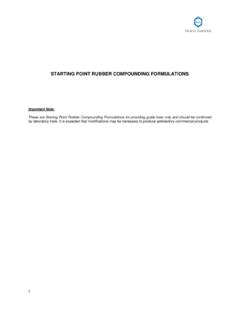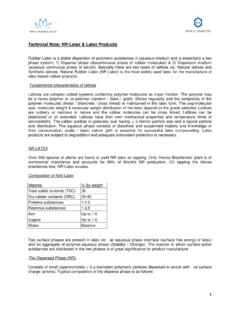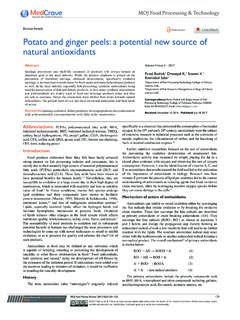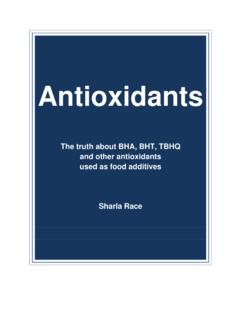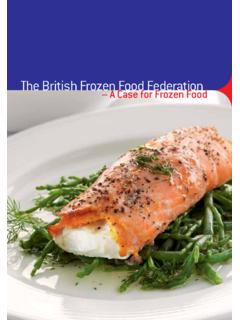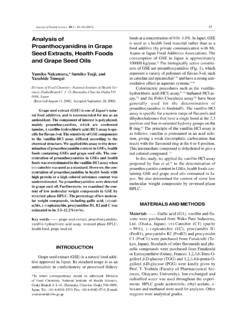Transcription of Antioxidants & Antidegradants - Nocil Ltd
1 1 Antioxidants & Antidegradants All polymers & products baded on them are subject to degradation on exposure to the degradative environments such as: - Storage aging - Oxygen - Heat - UV Light & Weathering - Catalytic degradation due to the presence of heavy metal Ions (Cu, Mn, Fe etc.) - Dynamic Flex - Fatigue - Ozone (Static / Dynamic / Intermittent exposure) These factors degrade rubbers / rubber products causing substantial changes in their technical properties and ultimately lead to their failure during service or shorten the expected service life in the absence of Antioxidants .
2 Type of Degradation Initiating / Accelerating Factors Degradation Causes Type of Failure Storage Aging Surrounding conditions Oxygen, Light, Heat, Humidity Loss of elasticity and tensile strength Aging due to Heat Heat Oxygen Loss of elasticity and tensile strength Aging due to Light & Weathering Light, UV light, heat, humidity, surrounding conditions Oxygen Formation of crazed surface, loss of elasticity and tensile strength Soluble Metal ion (Cu,Mn,Fe) catalyzed oxidation Cu, Mn, Fe, Co & Ni Ions as their rubber soluble fatty acid salts Oxygen Rapid loss in elasticity and tensile strength. Flex-Fatigue cracking Intermittent mechanical strains Oxygen, Ozone, Flaws Appearance of cracks (cracking patterns usually complex) Ozone Cracking Continuous / Intermittent strains Ozone Extensive cracking at right angles to the force causing strain Polymer Degradation Chemistry The formation of free radicals (R.)
3 During polymerization, processing or service of the rubber product is the first stage of polymer degradation and is called as Initiation of degradation process. Propagation is the second stage when atmospheric oxygen reacts with the free radicals (R.) to form Peroxy ( ROO. ) radicals Peroxy radical further reacts with labile Hydrogen atom of the polymer to form unstable hydroperoxides (ROOH). ROO. + RH ROOH + R. 2 Hydro peroxides immediately decompose via hemolytic cleavage to form alkoxy and hydroxyl radicals and further propagate the degradation mechanism.
4 ROOH RO. + .OH . Propagation stage of degradation process is very rapid compared to the Initiation stage. This autocatalytic oxidation reaction progresses until termination takes place by formation of stable products. 3 Free radicals R. can undergo following reactions depending on their own relative stability : - Dimerize (cross link), - Disproportionate (exchange H. becoming alkane & olefin), - Abstract H. (chain transfer), - Cleave (rupture polymer chain), - Rearrange, - React with oxygen. Auto-oxidation depends on the relative C H bond dissociation energy. Strongest Bond Weakest Bond Primary Secondary Tertiary Allyic kcal.
5 Kcal kcal kcal R CH2 H R2CH H R3C H RCH=CH-CRH-H Dimerization causes polymer hardening while cleavage reduces polymer chain lengths (change in hardness & elastic properties and causing fatigue crack initiation points. Cleavage may also release of gases (resulting in separations). Since all the vulcanization ingredients are still present; degradation can take place by continued changes in the state of vulcanization during the rubber product service. This causes Reversion or marching modulus due to changes in the nature of the sulphur cross links. The Termination Stage reactions progress as follows : A) Chain Scission 2 R2 HCOO. R2C=O + R2 CHOH + O2 ROO. + .OH ROH + O2 Scission predominates in polymers like NR, IR, IIR (unsaturated polymers which have electron donating groups such as -CH3 attached to the carbon atom adjacent to the double bond and hence vulnerable).
6 Scission results in the decrease of molecular weight leading to softening of the aged / over cured vulcanizates, reduction in tensile properties etc. B) Cross linking 2 R . R R 2 R3 COO . R3 COOCR3 + O2 4 2 RO . ROOR R . + ROO . ROOR Cross linking predominates in case of polymers like BR, SBR, NBR, CR, etc. which have comparatively less active double bonds or somewhat deactivated double bonds due to the presence of electron-withdrawing groups such as halogens ( CR, Chloro/Bromo Butyl Rubbers).
7 Cross linking results in brittleness, gelation and reduction in elongation of the polymer. EEffffeecctt ooff DDeeggrraaddaattiioonn oonn EEllaassttoommeerrss EEllaassttoommeerrss EEffffeecctt OOff DDeeggrraaddaattiioonn Natural Rubber ( NR ) Scission ( Softens ) Poly Isoprene ( IR ) Scission ( Softens ) Polychloroprene ( CR ) Cross linking & Scission ( Harden ) Styrene Butadiene Rubber ( SBR ) Cross linking & Scission ( Harden ) Acrylo Nitrile Butadiene Rubber ( NBR ) Cross linking ( Harden ) Polybutadiene Rubber ( BR ) Cross linking ( Harden ) Isobutylene Isoprene Rubber ( IIR ) Scission ( Softens ) Ethylene Propylene Rubber ( EPM ) Cross linking & Scission ( Harden ) Ethylene Propylene Ter-polymer ( EPDM ) Cross linking & Scission ( Harden ) Chlorosulfonated Polyethylene ( CSM ) Cross linking ( Harden ) Polyacrylic Rubber ( ACM ) Cross linking ( Harden )
8 Fluorinated Hydrocarbon Rubbers ( FPM ) Cross linking ( Harden ) Polysulfide Rubbers ( T ) Cross linking ( Harden ) Chloro Isobutylene Isoprene Rubber ( CIIR ) Cross linking ( Harden ) This model does not account several factors. Other factors to be considered are : o Relative oxidation rates of different polymers, o Presence of amorphous and crystalline zones in polymers, o Bulk properties which limit oxygen permeation, o Various mix of polymer structures,Reactive nature and structure of propagating radicals R. & ROO. Differences in polymer crystallinity (some polymers have both amorphous and crystalline phase ( SBS copolymer). Free radicals generally migrate to the amorphous phase and the oxidation takes place in this phase. The presence of metallic ions such as Cu, Mn, Fe, Co cause catalytic peroxide break down that accelerates the initiation of oxidation.)
9 The permeability of oxygen into a polymer is a key factor that will affect the overall oxidation. 5 EFFECT OF OXYGEN: Only 1 2 % of combined oxygen is enough to render the rubber product useless. Polymer oxidation is a complex process involving many factors -processing conditions ( temperature, shear rate), presence of catalysts of oxidation, compounding formulation design etc. Oxidation causes Chain scission and Cross linking resulting in the loss of elastic properties of vulcanizates. Both occur simultaneously - the one which prevails, determines the final product properties. The cure system selection also influences the ageing resistance of the rubber product.
10 The Conventional Cure Systems are more prone to oxidative degradation than the Semi EV or EV Cure systems. EFFECT OF HEAT : Heat accelerates the process of oxidation and effects of oxidation are observed sooner and are more severe as the temperature increases. In case of NR, in the absence of oxygen, more cross links are formed initially, followed by Reversion as cross links and polymer chains are broken. The oxidative heat ageing causes loss of Tensile Strength, Elongation at Break and overall Elasticity of the rubber vulcanizates. Effect of Heat on NR Vulcanizates: Temperature, C Combined Oxygen, % Loss of Tensile Strength, % 60 50 110 50 110 Nil. ( atmosphere) Negligible EFFECT OF UV - LIGHT & WEATHERING: UV-light promotes free radical oxidation of the rubber surface which results in the formation of a film of oxidized rubber on the surface of the product (called as Frosting).

